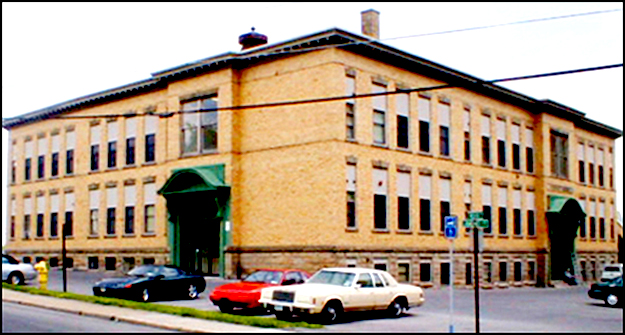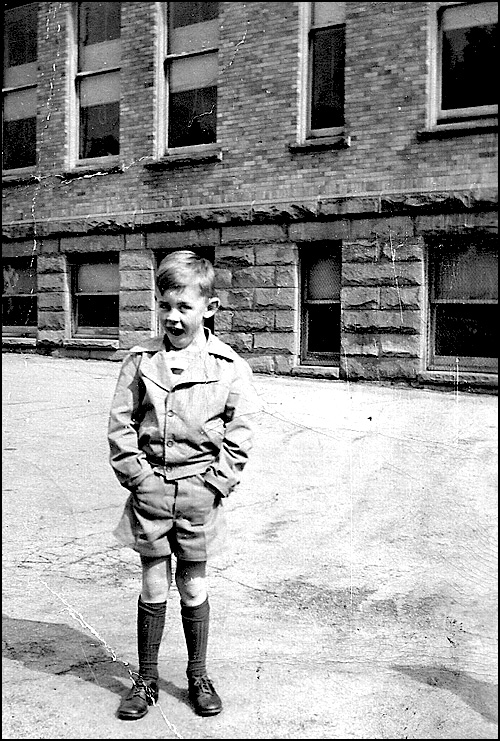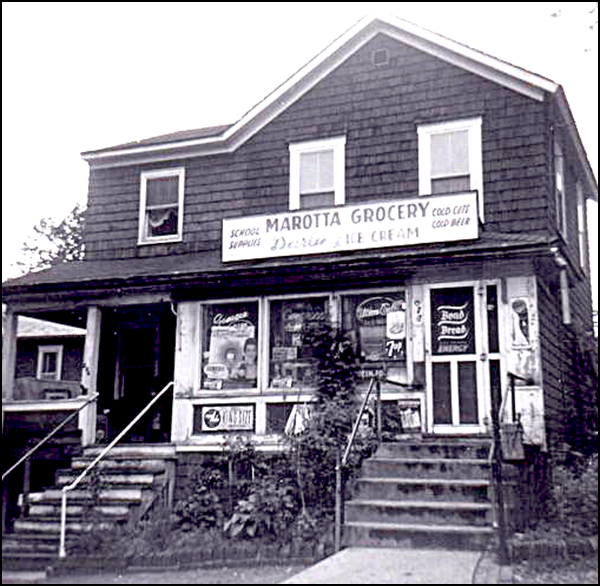| HOME |
 |
 |
From both schools you advanced to Intermediate – our middle school ... junior high ... call it what you will. Originally the Intermediate building had housed the Solvay high school. But that was during my father's time. The "new" Solvay High School was on Hazard Street ... until it gave way to an even newer building. The suddenly older high school replaced Intermediate, which was torn down and replaced by an elementary school that served the entire village. Boyd School was torn down and replaced by a park. That left Prospect as he last school standing, though it's no longer a school, but an apartment building after having served the village in other ways, such as headquarters of the Solvay Police Youth League. EXCEPT for the green paint on the doorways – and for the newer doors themselves – the building still looks like the Prospect School of my memory. Several memories, actually, most of them good. Like Miss Tabor, the kindergarten teacher. Don't know if things have changed, but for many years Solvay children began school at one of two times during the year, in September or January. You were expected to spend a year in kindergarten, which was split between morning kindergarten and afternoon kindergarten. I don't remember which one came first. I do remember that even though we spent only half a day at school during our kindergarten year, Miss Tabor had us lie on mats every day for a nap, though I don't think anyone ever fell asleep. I don't know if the naps were for our benefit or hers. They were like today's "time outs," I suppose. My happiest day was when I was summoned, along with three others – I believe they were Pete Corbett, Margaret Mortas and Carol Bianchi – and told we had been instantly promoted a half year. I'm not sure how we were selected, though with Pete and myself it may have been because we were noticeably taller than the other boys in our class. Anyway, my mother had mixed feelings about the news. She liked that I was singled out this way, but was already fretting that the move put me in a January graduating class. She preferred a June ceremony. I don't remember her reasons, none of which would matter because six years later I was pushed ahead again, back into a June graduating class. |
 |
| My first day at Prospect School. Love the outfit. |
MISS BUCKLEY, my first grade teacher, was a short, round woman who seemed older than she probably was, a frequent mistake when you view adults through eyes that are only six-year-old. I liked Miss Buckley ... most of the time. However, she did one thing that really bugged me; I guess because what she did threatened to interfere with my lunch. It was as true then as it is today, don't mess with me when I'm hungry. Most Prospect School students walked home for lunch. I had one of the longer walks, but usually made it home and back with minutes to spare. The obstacle was Miss Buckley's special torture which began as noon approached when she instructed us to empty a bag of Scrabble-like letters (without the assigned point value) on our desks and spell certain words. We couldn't leave the classroom until we had spelled these words correctly and put the letters back in the bag. There were times I felt like throwing that bag at Miss Buckley's head. SOMETHING worse awaited. That would be second grade and Miss Braude, considered the school's meanest teacher. Thoughts of Miss Braude came back to me when my children were in elementary school in Cranston, Rhode Island, and they'd rate their teachers on a scale that went from Nice to Mean. My wife and I were friends with the "meanest" teacher at my children's school; we knew how nice she really was. Perhaps it was that way with Miss Braude, too However, Miss Braude was stern and unsmiling. Her demeanor, coupled with her reputation kept almost all of us in line. An exception was a girl named Esther DeJohn, who should have been in a special class, but was not yet old enough to qualify under the standards of the 1940s. Esther and Miss Braude butted heads several times. Most memorable was Esther's retaliation during the most unpleasant task of the day, which involved a milk break. All of us were expected to drink a small bottle of milk, which was seldom cold and often tasted spoiled. It was the reason I stopped drinking white milk, insisting on chocolate-flavored milk from then on. Anyway, after finishing this vile liquid, students would walk to the cloakroom in the back of the classroom, rinse out their bottles (after dumping most of the milk down the drain), then walk the bottles to a case that was kept near the classroom door. Miss Braude made it a point to sit in a chair she had placed next to the case. That is, until Esther began leaving about an inch of water in her bottle. When Esther walked toward the door she did so carrying the bottle in her right arm, which she swung back and forth. As the closed in on Miss Braude, Esther tilted the bottle forward and sprayed the teacher with the water. As far as I know, that was Esther's last year at Prospect School. As for Rebecca Braude, she must have been a remarkable. When she died in 2007 she was 104 years old. Her obituary said she had taught at Boyd School for several years. That may be true, but she was at Prospect School in the 1940s and I have her signature on my report card to prove it. My report card also seems to indicate she was one hell of a teacher, though second grade was simpler then than it is today. (One of the "subjects" on my report card was Health Habits, which included posture, neatness, cleanliness and – my favorite – use of handkerchief.) MISS SMILEY, my third grade teacher, had the most memorable name, one that probably prompted a lot of corny remarks during her teaching career. However, my time in her class is a period that seems blank by comparison with the rest of my time at Prospect School. I remember this much: Miss Smiley was one of the school's younger teachers, but as I said earlier, when you're an elementary school student, you are unable to accurately gauge the age of an adult. Mrs. Mulloy, my fourth grade teacher, was my favorite, a relatively cheerful woman who, more than the others, made learning almost fun. Up next was Miss Thibault, a gaunt, stern-looking woman who was nearly as intimidating as Miss Braude. Miss Thibault also looked like someone from the previous century, but as the weeks passed she warmed to her students and we to her, though we understood we should keep this to ourselves. I think teacher's appreciate having a reputation for being tough. BEFORE I get to sixth grade, a few other recollections of Prospect School: There was a small gymnasium/auditorium in the basement. I can't recall most of the activities included in our physical education classes, but one is etched in my brain. Not surprisingly it is the sport that was at the heart of controversy a few years ago: dodge ball. I admit my initial experience with dodge ball was unpleasant, almost traumatic, the kind of thing induces nightmares. ("People are throwing a ball at me!! Make them stop!!") Notice I said "ball." Singular. I do not recall playing the kind of dodge ball I've seen in movies and on television where there are three, four or five balls in play at one time. Maybe Prospect School could afford only one ball. Perhaps my memory is faulty. All I know is that for a couple of years I dreaded dodge ball. That changed by sixth grade and when I played it in high school it was one of my favorite games. I think everyone should be subjected to it. They'll either love it like I do ... or years later have something to share with their shrink. WORST EXPERIENCE at Prospect School? Well, beyond even the spoiled milk that permanently gagged me, the care provided by the school's dentist (who shall remain nameless) takes the prize. Hands down. Yes, we had a school dentist who'd check our teeth in an equipped office located in the basement. Granted, it was my fault for having rotten teeth to begin with. Where the dentist got into the act was drilling away only some of the cavity before he filled the hole. Years later I had three months' worth of weekly visits to an extraordinary Syracuse dentist who cleaned out what was left of my teeth, blaming much of the mess on that school dentist. Also worse than the spoiled milk was a reflex conditioned by comments made in class by my sixth grade teacher, Frances Kelly, in 1949.( I learned recently that Miss Kelly had been teaching at Prospect School since 1910, perhaps even earlier.) She had peculiar notions that might have inspired some Stephen King novels. One involved someone she knew or had read about who developed an illness that pushed her eyeballs forward so they looked like they might pop out of her head. I have met people whose eyeballs bulge a bit; whether there was a student who had this look about him or her, I do not recall. I cannot imagine why a teacher would talk about this with sixth graders. The upshot is that for a long time afterward I would impulsively lay the index fingers of both hands on my face, from my cheekbones to my forehead, to test the forward progress of my eyeballs. The other Miss Kelly story, while intended to frighten us, was so silly that I couldn't take it seriously. Like I said, this was 1949, and the story should have been buried when Germany surrendered four years earlier. According to Miss Kelly, the Germans invented the bicycle for the purpose of killing American children, who'd inevitably be hit by automobiles or have other horrible accidents on their two-wheelers. Whether a bicycle mishap triggered this outburst I cannot recall. NO TALE about Prospect School during this period of Solvay history would be complete without mentioning Marotta's Store, located on Lamont Avenue, across the street from the school's side entrance Marotta's was a teeny store, probably originally a living room when the building was erected. The family lived there; the store area and living quarters were separated by a curtain-covered doorway. That store was a godsend in countless emergencies when my mother needed something — fast. She had no driver's license, so until I could use the car I was assigned to walk the seven-or-so blocks to Marotta's for bread, milk, whatever. It also was the place to go for bubble gum and baseball cards. If there's such a thing as a hangout for elementary school kids, Marotta's was it. I don't think many of today's children have a Marotta's, a place they can walk to unsupervised by a parent who'll offer unwanted advice about how to spend their allowance (if, indeed, kids have allowances anymore). I was thankful my first two children had such a place within walking distance of our home in Warwick, Rhode Island. It was called Joe's. Only years later did I know how often my children went to Joe's. I probably wouldn't have approved at the time. Which is why I'm glad my kids didn't tell me until I was old enough to understand. |
 |
Marotta's grocery store, across the street from Prospect |
| For more on Solvay way back when, check out the Solvay-Geddes Historical Society |
| HOME • CONTACT |
